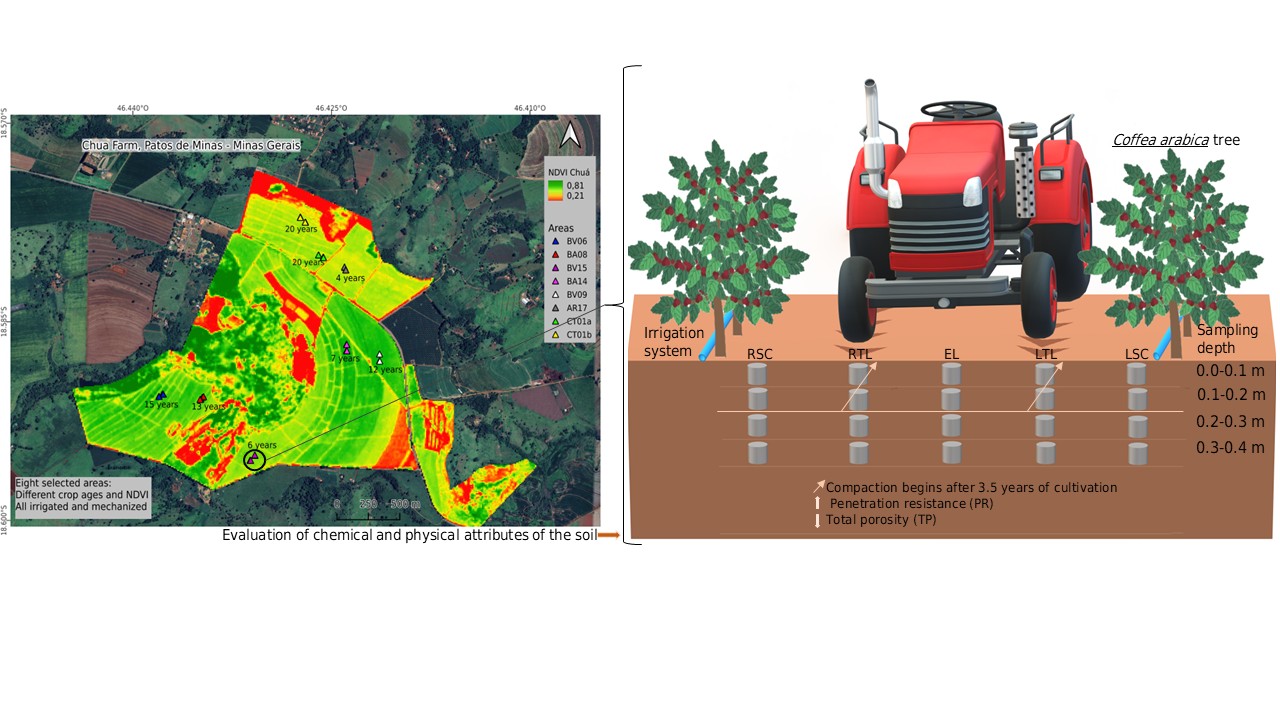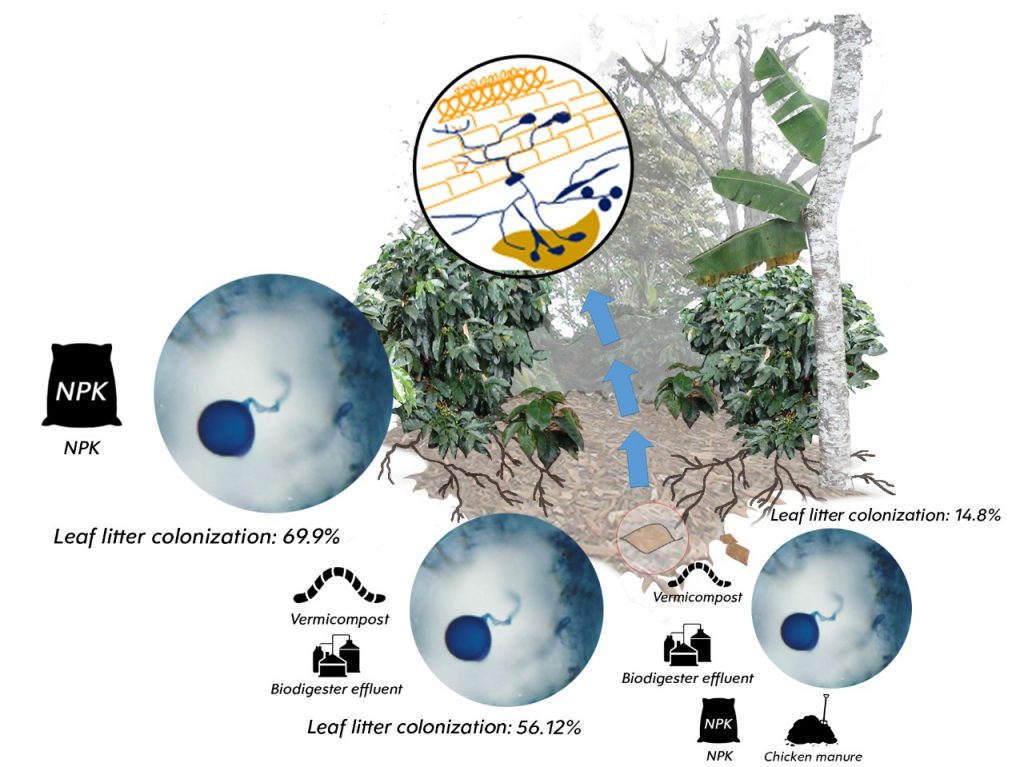Mechanized and irrigated coffee cultivation promotes physical subsurface constraints in Oxisols
16/Jun/2025
ABSTRACT Soils of the Cerrados (Brazilian Savanna) are deep, well-structured, and well-drained, with flat to gently undulating terrain that favors mechanization for coffee cultivation. However, these soils are susceptible to compaction. This study aimed to assess the effect of mechanization on the physical characteristics of an Oxisol under irrigated coffee cultivation in the Alto Paranaíba-Minas Gerais State. We selected eight areas with different cultivars and years of Arabica coffee plantation, sampling five positions: right soil under the tree crown (RSC), […]
Occurrence of arbuscular mycorrhizal fungi in leaf litter and roots of shaded coffee plantations under organic and conventional management
15/Feb/2021
ABSTRACT Evidence of arbuscular mycorrhizal fungal colonization of mat litter in various ecosystems plus previous reports of external mycelium of those fungi and mycorrhizal roots in litter from coffee plants and shade trees on coffee plantations suggest that they have a relationship with closed direct nutrient cycling between organic matter and living roots. This relationship was first proposed more than 50 years ago. Mycorrhizal symbiosis in tropical crops is affected by agricultural management practices. This study aimed to assess the […]
Polyol-ester impact on boron foliar absorption and remobilization in cotton and coffee trees
08/Oct/2020
ABSTRACT Foliar fertilization can be recommended to treat boron (B) deficiency in coffee and cotton. Considering that B foliar fertilizers with polyol-boron complexes can affect B uptake and mobility differently within the plant, and coffee and cotton have different cuticles and stomata density, a differential response would be expected. We aimed to study the foliar application of boric acid combined with sorbitol on B uptake and translocation in cotton and coffee. Green-house grown plants received B as boric acid and […]
Effect of potassium sources and rates on arabica coffee yield, nutrition, and macronutrient export
01/Oct/2014
The use of potassium (K) rock powder can be an alternative for K supply of crops. Thus, to reduce K fertilizer imports from abroad, possibilities of extracting this nutrient from Brazilian rocks are being studied. The objective was to evaluate the effect of phonolite rock powder (F2) as K source (Ekosil®) on the air-dried fruit yield, nutrition and macronutrient export of Arabica coffee. The experiment was carried out on a dystroferric Red Latosol (Typic Haplorthox), in Piraju, São Paulo State, […]
Yield gains of coffee plants from phosphorus fertilization may not be generalized for high density planting
01/Jun/2014
Inconclusive responses of the adult coffee plant to phosphorus fertilization have been reported in the literature, especially when dealing with application of this nutrient in high density planting systems. Thus, this study was carried out for the purpose of assessing the response of adult coffee plants at high planting density in full production (in regard to yield and their biennial cycle/stability) to the addition of different sources and application rates of P in the Zona da Mata region of Minas […]
High soil silicon concentrations inhibit coffee root growth without affecting leaf gas exchange
01/Jun/2011
Several studies have confirmed the benefits of silicon (Si) for crop growth. The purpose of this study was to evaluate the effects of Si on the initial growth of coffee plants cv. Catuaí Vermelho. This study was carried out with potted plants grown in a greenhouse, without water deficiency. Dry matter partitioning of roots, stems and leaves as well as the chemical composition of plant tissues and soil and leaf gas exchange were evaluated in plants treated with 0 (control), […]
Effect of calcium silicate suplly and the nutritional efficiency of coffee cultivars
01/Dec/2009
Silicon is classified as a beneficial nutrient and can improve the nutritional dynamics of plants, although it is not considered an essential nutrient for plants. In an experiment in a randomized block design, three coffee cultivars (Catuaí, Mundo Novo and Icatu) were planted in plastic tubes, combined with six doses of calcium silicate (T0=0, T1=0.063, T2=0.125, T3=0.25, T4=0.5 and T5=1.0 g dm-3 substrate), to compare the nutritional efficiency of the cultivars in response to silicon fertilization. Cultivar Icatu showed the […]
Nutritional diagnosis of coffee plantations in the Upper Jequitinhonha Valley, Minas Gerais State, Brazil: dris norms and critical nutrient ranges
01/Aug/2009
In the Diagnosis and Recommendation Integrated System (DRIS), norms for coffee in the Upper Jequitinhonha Valley, Minas Gerais, Brazil, have not been established yet. The lack of these norms hinders the application of the DRIS to the coffee plantations in the region. The foliar diagnosis, based on the DRIS and on critical reference ranges, stands out among the tools that allow an efficient use of fertilizers. This study aimed to determine DRIS norms as well as to establish values of […]
Nitrate reductase and glutamine synthetase activity in coffee leaves during fruit development
01/Apr/2009
Nitrate reductase is the first enzyme in the pathway of nitrate reduction by plants, followed by glutamine synthetase, which incorporates ammonia to glutamine. The purpose of this study was to evaluate the nitrate reductase and glutamine synthetase activity, total soluble protein content, N and Ni content in coffee leaves during fruit development under field conditions to establish new informations to help assess the N nutritional status and fertilizer management. The experimental design was in randomized complete blocks, arranged in a […]
Relationship between zinc content in coffee plants and soil availability according to the soil extractant
01/Oct/2007
Two species of coffee (Coffea arabica L. and Coffea canephora Pierre) are cultivated in Brazil, but most research on Zn fertilization to date has focused on C. arabica. This study was carried out to determine the functional relationship between soil Zn availability determined by DTPA and Mehlich-1 extractors and Zn content in coffee plants belonging to the species C. arabica, cv. Mundo Novo IAC 379-19 (MN) and C. canephora, cv. Apoatã IAC 2258 (AP), as well as grafted plants (MN/AP). […]


